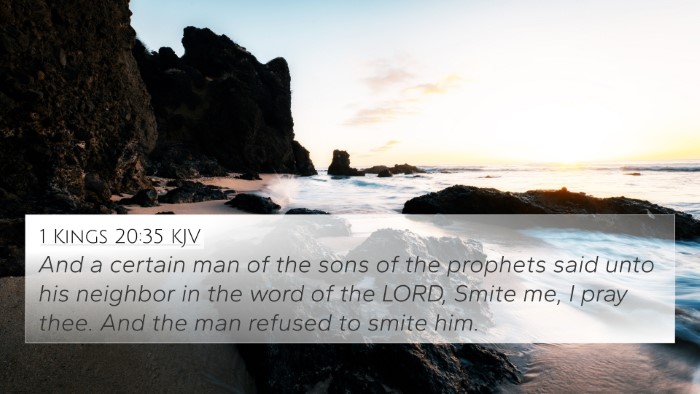Understanding 1 Kings 20:37
Bible Verse: "Then he found another man, and said, 'Strike me, please.' And the man struck him, inflicting a wound." (1 Kings 20:37, ESV)
This verse presents a moment of significant symbolism and prophetic implication within the narrative of the kings of Israel. In this analysis, we will explore the multifaceted meanings derived from this passage, drawing on esteemed public domain commentaries.
Summary of Interpretative Insights:
- Matthew Henry: Henry highlights the prophetic aspect of the scenario. He explains that the man who was instructed to strike was conveying God’s message of judgment to Ahab, showing a deeper theme of disgrace and divine displeasure aimed at the king.
- Albert Barnes: Barnes notes the significance of the physical injury as a representation of God’s warnings. It serves as a reminder of the consequences of Ahab's previous sins and the way this injury foreshadows the calamity that awaits him.
- Adam Clarke: Clarke elaborates on the psychological dimension here, pointing out that the act of being struck reflects Ahab’s relationship with the Lord, his guilt, and the forthcoming judgment that is to be fully revealed through subsequent events.
Thematic Connections
The narrative showcases themes of prophecy, judgment, and the blatant disregard of faith. It illustrates the dynamic relationship that exists between human actions and divine outcomes, a recurring theme throughout scripture.
Bible Verse Cross-References:
- 2 Samuel 12:9-10: David's sin leads to severe consequences, similar to Ahab's actions.
- 1 Kings 21:21-22: Ahab's fate is sealed with prophesies of destruction owing to his idolatry.
- Jeremiah 14:16: The judgment against Israel mirrors the situation with Ahab in terms of consequences from disobedience.
- Ezekiel 18:30-31: The call for repentance and the awareness of judgment play central roles in both contexts.
- Luke 12:47-48: Jesus speaks of the consequences faced by those who know their master’s will, paralleling Ahab’s knowledge of God's commandments.
- Matthew 26:54: The inevitability of prophecy coming to pass based on human actions is a theme in both verses.
- Revelation 16:15: The imagery of fear and unexpected judgment parallels the underlying meanings in Ahab’s narrative.
Detailed Analysis of Connections between Bible Verses
In exploring the connections between Bible verses, particularly in 1 Kings 20:37, one can identify a series of inter-Biblical dialogues that add depth to our understanding of divine justice. It becomes clear that numerous scriptures reference the consequences of disobedience, coinciding with the prophetic messages found in the Old Testament.
Furthermore, Bible concordances and cross-reference guides can serve as essential tools for uncovering these thematic connections. Utilizing elements like Bible chain references can lead to a deeper realization of how this single verse serves within the broader context of scriptural teachings.
Tools for Bible Cross-Referencing:
- Use of digital Bible concordance tools for finding related scriptures efficiently.
- Employing a Bible reference system for organized thematic study.
- Exploration of cross-reference Bible study methods tailored to personal or group study.
- Access to comprehensive Bible cross-reference materials for enriched understanding.
Applying Insights in Study
For those seeking to deepen their Bible study experience, understanding how to find cross-references in the Bible is invaluable. Pairing verses like 1 Kings 20:37 with other relevant scriptures allows one to create a network of theological understanding. This encourages a more profound exploration of themes such as accountability, the influence of evil kings, and the significance of prophetic actions.
Conclusion
1 Kings 20:37 is not merely a historical account but a rich source of teaching that reflects on God's justice and the need for accountability. By utilizing cross-referencing techniques, readers can discern deeper truths and better understand the interconnectedness found throughout the Bible. Such practices enhance our comprehension of scriptural narratives and their implications in the lives of believers today.




